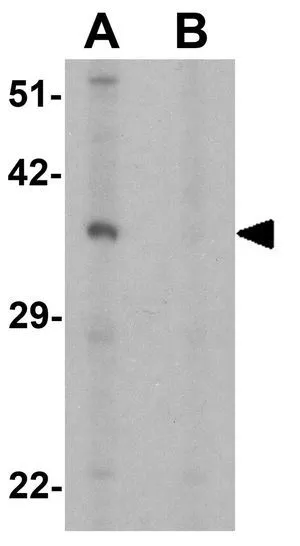OLIG2 antibody [HL1072]
GTX636104
ApplicationsImmunoFluorescence, ImmunoCytoChemistry, ImmunoHistoChemistry, ImmunoHistoChemistry Frozen, ImmunoHistoChemistry Paraffin
Product group Antibodies
TargetOLIG2
Overview
- SupplierGeneTex
- Product NameOLIG2 antibody [HL1072]
- Delivery Days Customer9
- Application Supplier NoteICC/IF: 1:100-1:1000. IHC-P: 1:100-1:1000. *Optimal dilutions/concentrations should be determined by the researcher.Not tested in other applications.
- ApplicationsImmunoFluorescence, ImmunoCytoChemistry, ImmunoHistoChemistry, ImmunoHistoChemistry Frozen, ImmunoHistoChemistry Paraffin
- CertificationResearch Use Only
- ClonalityMonoclonal
- Clone IDHL1072
- Concentration1 mg/ml
- ConjugateUnconjugated
- Gene ID10215
- Target nameOLIG2
- Target descriptionoligodendrocyte transcription factor 2
- Target synonymsBHLHB1, OLIGO2, PRKCBP2, RACK17, bHLHe19, oligodendrocyte transcription factor 2, basic domain, helix-loop-helix protein, class B, 1, class B basic helix-loop-helix protein 1, class E basic helix-loop-helix protein 19, human protein kinase C-binding protein RACK17, oligodendrocyte lineage transcription factor 2, oligodendrocyte-specific bHLH transcription factor 2, protein kinase C-binding protein 2
- HostRabbit
- IsotypeIgG
- Protein IDQ13516
- Protein NameOligodendrocyte transcription factor 2
- Scientific DescriptionThis gene encodes a basic helix-loop-helix transcription factor which is expressed in oligodendroglial tumors of the brain. The protein is an essential regulator of ventral neuroectodermal progenitor cell fate. The gene is involved in a chromosomal translocation t(14;21)(q11.2;q22) associated with T-cell acute lymphoblastic leukemia. Its chromosomal location is within a region of chromosome 21 which has been suggested to play a role in learning deficits associated with Down syndrome. [provided by RefSeq, Jul 2008]
- Storage Instruction-20°C or -80°C,2°C to 8°C
- UNSPSC12352203
References
- Yao P, Yu Q, Zhu L, et al. Wnt/PCP pathway regulates the migration and neural differentiation of mesenchymal stem cells in vitro. Folia Histochem Cytobiol. 2022,60(1):44-54. doi: 10.5603/FHC.a2022.0006Read this paper

![ELISA analysis of antigen using GTX60398 OLIG2 antibody [1G11]. Red : Control antigen 100ng Purple : Antigen 10ng Green : Antigen 50ng Blue : Antigen 100ng](https://www.genetex.com/upload/website/prouct_img/normal/GTX60398/GTX60398_20170912_ELISA_w_23061123_935.webp)




